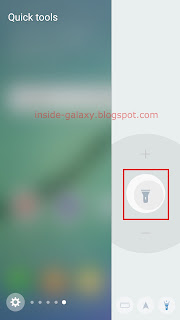Front side layout of Samsung Galaxy S7 Edge
- SIM card tray(at the top side of the phone): use this tray to place two nano SIM cards to use dual SIM mode or a nano SIM card and micro SD card to use single SIM mode.
- Microphone (at the top side of the phone).
- LED indicator: it'll light up or flash red or blue while the screen is off to notify you when the battery level is low or being charged, voice recording, or receiving notifications.
- Light/proximity sensor: this sensor is used to make some features work when it's blocked by an object, as the example, the screen will auto turn off when this sensor is blocked by your face or ear during calls, the screen will auto turn on when you move your hand above this sensor, etc.
- Speaker.
- 5MP Front camera: you can use this to take a self-portrait photo. This camera is also used by the phone to make some features work, as the example, it'll detect your face so that the screen will stay on while you're looking at it.
- Volume button: press this button to adjust the volume.
- Touch screen/main screen: use it to use apps, navigate your phone, etc.
- Power button: press this button to turn on or lock the screen. Long press this button to turn on or off the phone, restart the phone, or turn on or off emergency mode.
- Edge screen: use it to view edge panels(e.g, task edge, people edge, apps edge, quick tools panel, etc.), edge feeds(e.g, unread notifications, S health notifications, Yahoo! news, etc). You can also set this screen to light up while the screen is facing downwards when you receive notifications.
- Recents key: tap this key to view the list of your recent apps. Long tap this key to launch the split screen view.
- Home button/fingerprints recognition sensor: press this button to turn on the screen when it's locked or return to the home screen. Long press this button to launch Google. When the screen lock type in your phone is set to fingerprints, you can use this button to recognize your registered fingerprint to unlock the screen.
- Back key: tap this key to return to the previous screen. Long tap this key to access additional options for the current screen.
- Headset jack(at the bottom side of the phone): use it to insert your headset.
- Multipurpose jack(at the bottom side of the phone): use it to insert a micro USB cable when you want to charge your phone or want to connect your phone to a PC. You can also use it to insert OTG adaptor so you can transfer data from other devices or connect USB peripheral devices, e.g., mouse, keyboard, etc, to your phone.
- Microphone(at the bottom side of the phone).
- Loud speaker(at the bottom side of the phone).
Back side layout of Samsung Galaxy S7 Edge
- 12MP Rear camera: you can use it to take a photo using various shooting modes and effects.
- Flash/heart rate sensor: it will light up when you turn on flash when taking photos, when you act your phone as a torch, or when you receive notifications if flash notification feature is enabled. You can also use it to measure your heart rate or easily take a self-portrait photo.
- NFC/MST antenna/Wireless charging coil: it will be used to pair your phone with other NFC capable device by holding them together back to back. It also be used to charge your phone with a wireless charger.
- Main antenna.



























